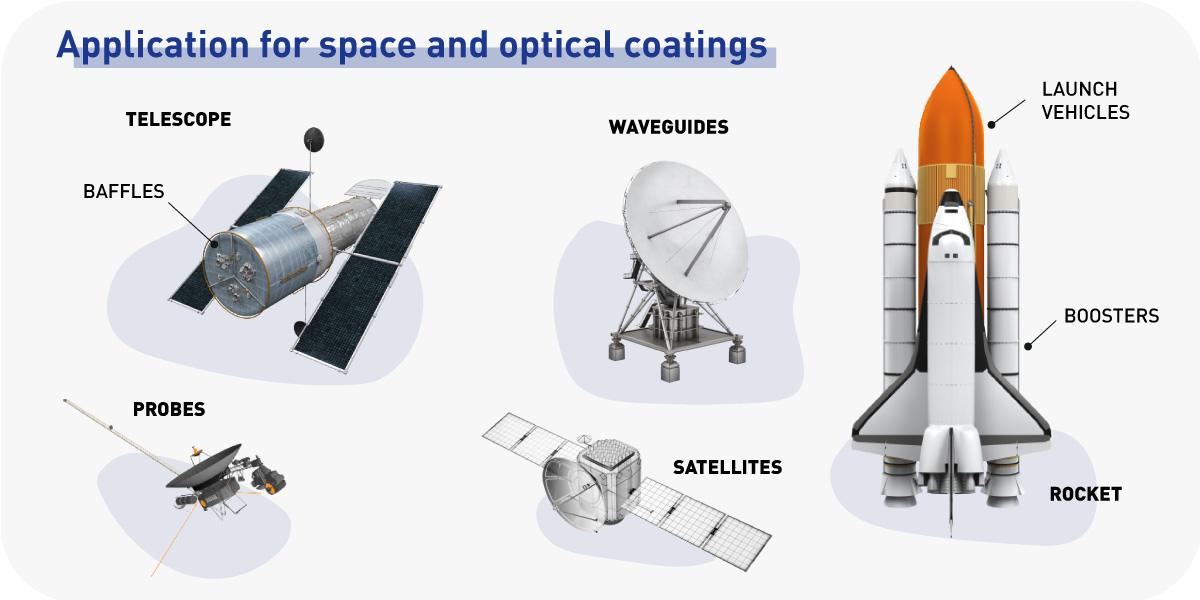Go to Space with SOCOMORE! Among the different ranges of coatings displayed by SOCOMORE, you will find an entire range of applications designed for the space and high-tech optical sectors. Let's focus on this dedicated range, with high added value, which will allow you to protect your equipment in this challenging and rigorous environment.
Why apply special coatings for space and optics?
Aerospace: a challenging field
Space applications, like the aeronautical field, leaves little room for error. This is a field where every element matters because space is a challenging environment.
This is also true for the various coatings that will go on the device or instrument (primers, top coats, varnish,...). The coating products used are selected specifically due to the stringent application requirements and harsh conditions that the part will be exposed to in space.
- Temperatures: Resistance to strong temperature variations, both positive and negative. Variations of more than 300°C are observed in operation. For example, the temperature around the International Space Station (ISS) can reach 121°C in the sun, while the other side without sunlight will be at -157°C.
- Thermal control: the successful thermal design of a spacecraft or space vehicle relies heavily on the use of coatings with specific hemispherical emittance, solar absorptance, and low outgassing properties.
- Corrosion: On the ground or in the air, corrosion is the scourge of aeronautics and aerospace. Space is a very corrosive environment due to the atomic oxygen that is present. Corrosion protection coatings are necessary.
- Electrical events: the build-up of electrostatic charges across insulative equipment can lead to unintended and dangerous electrical events. It is therefore necessary to apply a conductive coating.
- Outgassing: materials such as coatings, adhesives, sealants, and lubricants are the most common source of outgassing in space vehicles. Outgassing products can condense on optical equipment and sensors and cause degraded performance, so it is imperative to select low outgassing materials.
Equip your space and optical devices with special coatings
To increase the longevity of your components, it is important to equip them with special coatings. But what kind of equipment and materials can be used?
SOCOMORE offers a full range of space coatings that may be applied in various applications:
- Telescopes
- Baffles
- Waveguides
- Vacuum test Chambers
- Probes
- Satellites
- Boosters
- Launch vehicles
Learn more about our space coating range, download our brochure below:


Being successful in space with reliable and proven coatings
To increase the lifetime and quality of your equipment in operation, protect it with our specialized coatings. Choose your coatings carefully.
For interior or exterior space applications, SOCOMORE coatings provide excellent performance. They increase the lifetime of your devices. Finally, these products dedicated to space and optics benefit from a long flight experience and a proven reliability.
The SOCOMORE group's coatings have been proven to withstand the most rigorous space environment. This is the case of the AEROGLAZE topcoats:
- AEROGLAZE Z306
- AEROGLAZE Z307
- AEROGLAZE A276
Among the many applications of these products, there are prestigious references such as:
- NASA's Hubble telescope
- NASA Space Shuttle program
- NASA's Long Duration Exposure Facility (LDEF) experiment
Focus on each type of specialized coating
High thermal absorptivity
Prepare your surfaces before painting with our range of high absorptivity coatings. The range consists of reflective and moisture-cure urethane coatings. In addition to being low outgassing, our products offer high solar absorption and are approved by leading manufacturers and maintenance companies.
>> Check out our AEROGLAZE Z3 Series
Thermal resistance coating
SOCOMORE offers a complete line of thermal protection coatings and varnishes for the aerospace industry. Our products are capable of resisting high temperatures (600°C - 1100°F) while providing good corrosion protection. These coatings are used to protect reactors, heat exchangers and all metal parts (including aluminum) exposed to high temperatures on a continuous or occasional basis.
Finally, they also offer a very good resistance to aeronautical fluids:
- Resistance to hydraulic fluids
- Resistance to engine oils
- Resistance to kerosene
- Resistance to salt spray over 100 hours
For example LFPH 006: an anti-corrosion coating for heating systems or heat exchangers.
Low outgassing coating
Outgassing is a process by which particles are transformed into gas (usually water, solvents, additives, polymers,...). In the space environment, it is a phenomenon that must be limited because the released gas can compromise the integrity of the device. It is even more critical for sensitive surfaces such as:
- Lenses
- Optical elements
- Stellar/solar sensor detectors
- Solar cells
Possible consequences are as follows:
- Degradation of thermal control surfaces by modification of thermo-optical characteristics: solar absorptivity, emissivity.
- Loss of performance of optical elements (lenses, mirrors, detectors) by the modification of the optical characteristics: transmission of the lenses, reflection of the mirrors, or increase of the diffusion.
- Contamination: the gas condenses on a surface and forms a film or droplets.
- Direct disturbance of measurements: stray light
- Electrical problems: For example inside the spacecraft, in the electronics compartments, residual gases can facilitate electrostatic discharges from high voltage components.
Controlling and limiting contamination during the conception phase of the satellite is therefore essential. ASTM E595 is the standard test method for determining whether a material is low outgassing. The materials are tested under thermal test vacuum to determine the outgassing properties of the materials.
SOCOMORE coatings dedicated to space have been tested to ASTM E595 and determined to be low outgassing. In particular, the AEROGLAZE coatings (for example A276).
Conductive coating
Against electrostatic charges use SOCOMORE conductive coatings. Our range of electrically conductive coatings and films offer protection against electrical phenomena as well as enhanced corrosion protection, high durability, high thermal absorption and low outgassing. They meet the specifications or are approved by most aerospace OEMs.
Coating against corrosion
To fight against corrosion, SOCOMORE provides you with corrosion primers, top coats and varnishes.
AEROGLAZE primers offer excellent adhesion and corrosion resistance for a wide variety of substrates used in space and optical applications.
- AEROGLAZE 9924
- AEROGLAZE 9929
- AEROGLAZE 9947
- AEROGLAZE 9741
For topcoat and especially for interior applications, SOCOMORE offers you the CHEMGLAZE Z451 topcoat. With a grey color, it prevents corrosion of metallic substrates. Its outstanding resistance to impact and abrasion as well as its flexibility make it the perfect ally for space applications.
Finally, you can also prevent corrosion on electronic parts. TD 20 is a transparent epoxy varnish to cover your printed circuit boards or other electronic components and prevent corrosion.
And you, what are your challenges?
Our teams can help you choose the best coating for your space and optics, contact us!
Or download our brochure to learn more about our full space coating range:















